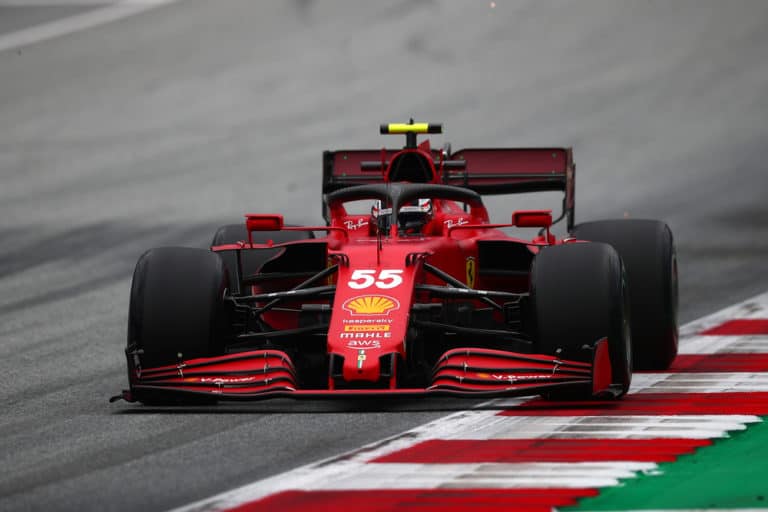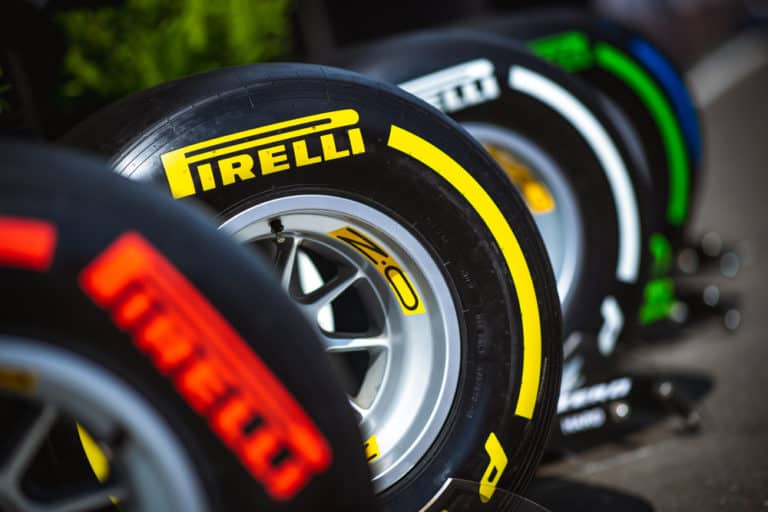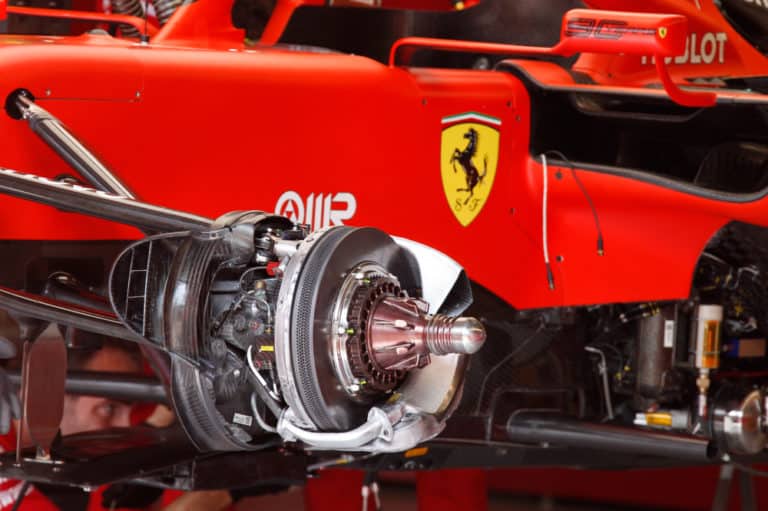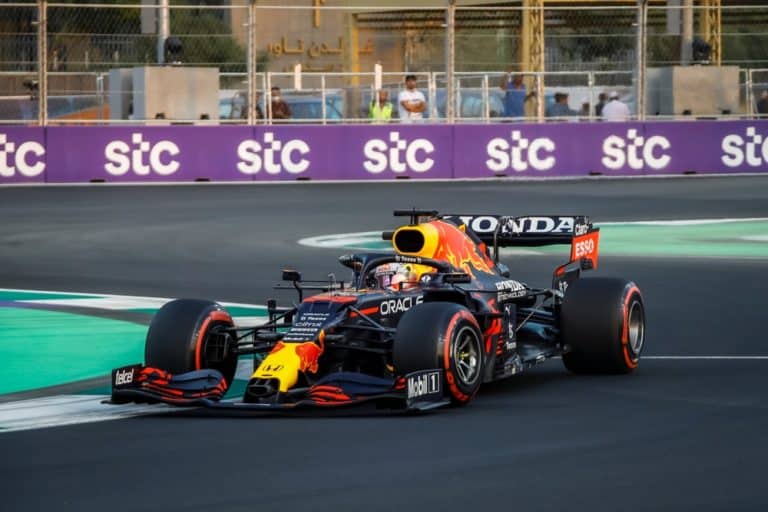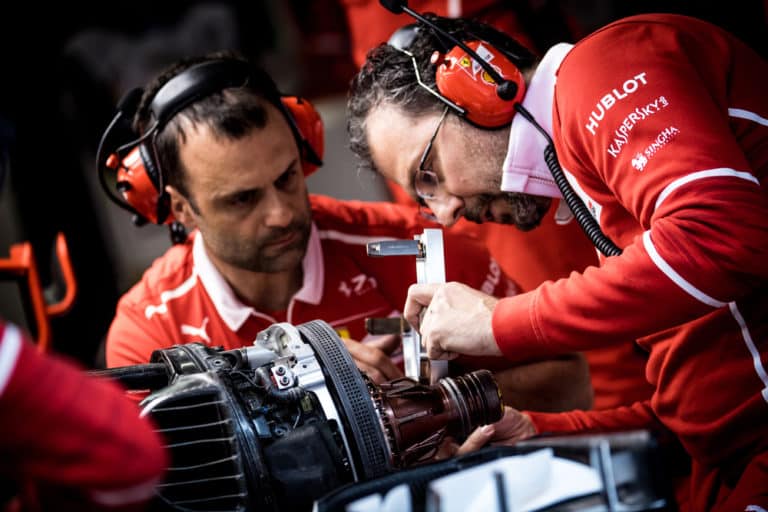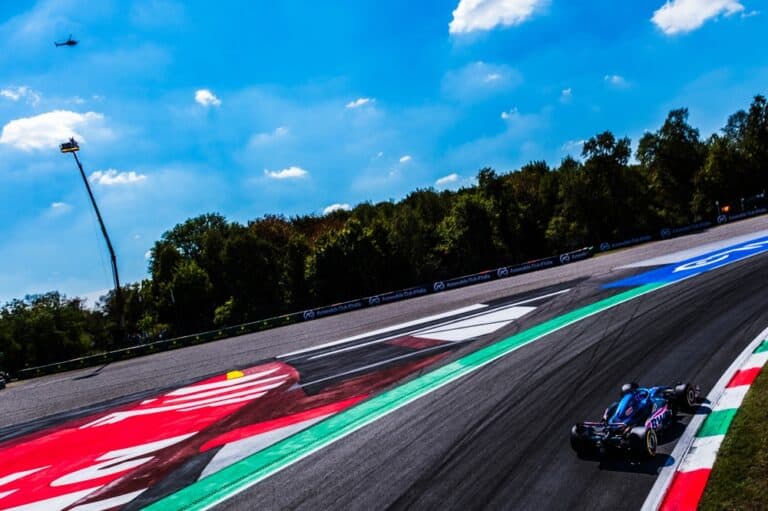Formula 1 engines are a marvel of modern-day motor engineering producing around 1,000 horsepower. They reach speeds of up to 216.9 mph and rev up to 15,00 rpm. These engines do not have a very long lifespan at these performance levels. So, how long does an F1 engine last anyway?
Formula 1 teams are only allowed three engines for a season, and each engine must last for at least seven races. The engines on an F1 car must last not only through three practice sessions but also during qualifying. Formula 1 teams must focus on engine reliability and improving efficiency.
The FIA has imposed strict penalties on teams that change an engine during the duration of an F1 season. We will explore a little more in-depth detail surrounding how these engines function and look at the reasons for an F1 engine failing.
Why Do F1 Engines Fail?
Formula 1 engines are not designed to fail; they are built to last for an entire Grand Prix season, around 22 races on an F1 calendar. However, they do fail, as several moving parts make up the engine, and any one of these parts could fail, resulting in a sometimes spectacular engine blowout on a racetrack.
The F1 engine is placed under tremendous amounts of stress and pressure, which is not a very good factor in the moving parts of an engine.
The pistons in an engine can move upwards to 39.7 millimeters and then move back down the same distance in one revolution. That is what is referred to as an engine stroke.
Formula 1 engines are only allowed to rev up to 15,000rpm, so each piston will travel a distance of 15,000 x 39.7 millimeters (1.56 inches) which is a total of about 46,800 inches, and that translates into 44mph.
That might not sound too fast, but each piston must accelerate upwards from its resting position to that speed and then decelerate back to zero before going through the entire cycle up and then back down again.
All the force generated from the pistons and the crankshaft creates a tremendous amount of strain on the movable parts of the engine, causing failures.
In addition, since these engines must last for seven races at most, they are continuously placed under all that stress and strain, which eventually causes failure in the engine.
Another contributing factor in engine failure is vibrations that arise from the racetrack and run through the entire car. These vibrations are not suitable for the engine moving parts and could cause parts of the engine to fail, resulting in catastrophic engine failures.
Here is a breakdown of the process explained to provide a little more insight into what goes on inside of an engine in one second.
- 360 liters of fuel and air mixture is used
- An entire liter of oil flows through the engine
- Three liters of engine coolant is pumped through the engine
- The pistons must endure more than 100 bar of pressure, which is about 1450psi
- The temperature at the surface of the piston reaches approximately 350 deg Celsius
- The temperature at the bottom surface of the piston reaches approximately 200 deg Celsius
Even the heat generated from the surface of the pistons could cause an engine to fail or break down, resulting in an engine blowout.
What Makes F1 Engines So Powerful?
Current F1 engines can generate around 1,000 bhp (billet horsepower), which is impressive for a 1.6-liter six-cylinder engine.
This amount of power output was only possible with 3-liter V10 engines last used in 2005. Even these 3-liter engines were only capable of producing about 950bhp.
The main component of an F1 car is the 1.6-liter V6 internal combustion engine.
The internal combustion engine, or ICE, functions as a regular combustion engine on a road car. The fuel goes into the engine and is mixed with compressed air from a turbocharger, and a very high-performance spark plug ignites the compressed air.
So far, the combustion process is standard compared to a regular road car. However, now the burn inside each cylinder is cleaner and more efficient, producing more power from the proportion of fuel that goes into the engine.
The ignition procedure is now a little more sophisticated. Instead of the spark plug being housed inside the combustion engine, the spark plug is housed in a separate pre-ignition chamber, which ignites three percent of the fuel-air mixture.
The three percent of the fuel-air mixture creates a “flame jet,” which ignites the 97% of the fuel-air mixture remaining, which results in a complete burn that produces more power and gives better efficiency.
The ICE can rev up to 15,000, allowing for the ICE to produce around 700bhp of the total power-unit output. The remaining 300 bhp is produced by two additional electric motors attached to the internal combustion engine.
The first of these electric motors, known as the MGU-K, is the kinetic energy recovery unit. The kinetic energy unit collects the energy produced from braking, typically lost.
Under heavy braking, the motor-generator unit works through a flywheel to produce electricity accumulated in a 20-kilogram lithium-ion battery packaged within the power unit. When the motor generating unit (MGU) is used in reverse, like a motor, it can produce up to a maximum of 120kW of power, which is comparable to around 160bhp.
The second motor-generator unit, the MGU-H, will convert heat into electricity, which is deployed when the driver starts to accelerate.
The MGU-H is housed between the compressor and turbine of the turbocharger above the V6 engine. When the exhaust gases rotate the turbine, they rotate the MGU-H through a shaft that connects the compressor and the turbine.
The electricity which is produced is also stored in the lithium-ion battery.
Under intense acceleration, the electricity gets used up to reduce turbo lag by rotating the compressor together with the flow of the exhaust gases over the turbocharger’s blades. The energy produced from the MGU-H is unrestricted, as it is with the MGU-K.
Working in harmony, the three motors, ICE, MGU-H, and MGU-K and the battery, together make up the most complex and costly power units that have ever been used in Formula 1.
They are also a lot more efficient than any power unit which has ever been used in motor racing. In comparison, the 3-liter V10 engines used fuel at a rate of 190kg/hr, so they were incredibly inefficient, using a lot more fuel to produce less power.
It is thanks to the sophisticated hybrid engine technology that creates more gains in the efficiency of the internal combustion engine. The outputs produced by the hybrid era power units are far more efficient, burning less fuel in the process.
How Have F1 Engines Evolved Over The Years?
The 1950s Engine Decade
The 1950s engines used all sorts of engines, from custom-built inline fours to pre-war V8’s. The only regulations were a limit on engine displacement, 4.5 liters if naturally aspirated, and 1.5 liters if a supercharger was fitted.
They produced around 425hp, producing about 94 horsepower per liter of fuel. In 1954 they tightened the restrictions and only allowed 2.5 liter naturally aspirated engines, reducing the power to 290hp.
However, teams got creative with engine layouts and managed to keep efficiency high, producing 116 horsepower per liter. The earlier engines were hefty and were fitted at the front of the car, which created colossal understeer, forcing the driver to neutralize this by sliding the cars around the corners.
This was also the decade where Formula 1 used mid-mounted engines. The mid-mounted engines got rid of the understeer, as the center of gravity was placed further back of the car.
The 1960s Engine Decade
Moving onto the 1960s, the FIA was concerned about the speed of the cars, as they were reaching around 180mph on the straight.
The FIA brought in the introduction of 1.5-liter engines that initially produced 150hp. This quickly increased to 250hp a few years later. These engines were capable of producing about 170 horsepower per liter. They were tremendously underpowered, with road cars and GT cars being a lot faster.
The lap times still came down over these years, forcing teams to focus on suspension and aerodynamics. It was mainly V8’s that were run, but teams began experimenting with wider ‘V’ angles to lower the engine in the car, improving handling.
In 1966, the FIA allowed teams to have a lot more power on engines, and the increased engine sizes to 3.5 liters naturally aspirated or 1.5 liters turbocharged. Teams mainly used mid-mounted engines, which produced around 500hp. Some teams experimented with larger inline fours and H-16 engines.
The 1970s Engine Decade
In the ’70s, teams got a little more creative and began playing with the idea of a 180-degree V12 engine, essentially making a “flat 12.” This allowed them to bring down the center of gravity and clean up the airflow to the rear wing.
As aerodynamics played a more significant role in the sport, engine power became a more prominent issue, too, as the cars began producing much more drag.
The regulations in the 70’s allowed for 3 liter naturally aspirated engines and 1.5-liter turbocharged engines. More teams found that naturally aspirated engines were more successful. In 1977, Renault introduced the 1.5-liter V6 with the RS-1, which sparked the turbo era of Formula 1.
Initially, it produced about 500hp but that soon went up to 700hp. It was a very experimental engine, and it also came with a few issues.
The heat produced some “hot spots” in the engine, which had the potential of igniting the fuel prematurely and causing the engine to blow up. This caused teams to use water injection to cool the block more evenly.
Over the next few years, all teams adopted a similar design, with some teams even using Toluene to fuel the car. This exotic fuel, combined with 5.5 bars of boost pressure, meant that the cars could produce up to 1400 horsepower for about five laps before blowing up.
The teams would turn up the boost for qualifying and replace the engine for the race. It did mean that they had to turn down the engines to last a total race distance, producing only around 800hp. This power, combined with the ground effect system, sent speed through the roof, meaning the sport became much more dangerous.
They were also challenging to drive as the turbine provided all of the power in one go.
The 1980s Engine Decade
In 1989, F1 dropped the use of turbochargers when they introduced a 3.5 liter naturally aspirated engine. This meant that teams had to build entirely new engines to meet the new regulations.
They all followed a “V” format, but they disagreed on the number of cylinders used. Honda was the leader in this regard, producing around 675hp from a V10 engine. These engines could produce 190 horsepower per liter.
This was the first era to produce a lower horsepower per liter than the previous engines. However, turbos were banned, and so were exotic fuels, and tighter regulations on how long the engines had to last were also introduced. The turbo era taught the teams some valuable lessons.
They developed engine components that used materials like titanium and Beryllium. These materials were needed for the turbo engines’ pressures; however, they could now be used to reduce weight and allow maximum revs.
However, this came with a new set of challenges. You needed to rev very high to create more power from a naturally aspirated engine. As the engines revved faster, the valves also needed to rev faster, and the timing of this could get much more complicated with the traditional camshaft system.
So, Honda started using high-pressure air to move the valves with much more accuracy; this is called pneumatic valve control and is a system that is still being used today.
The 1990s Engine Decade
Around the end of the 90s, the engines reached around 800hp and were back to the previous decade’s power numbers of the turbo cars.
From 1995, they used 3 liter naturally aspirated engines and banned exotic alloys as they were used extensively in the ’90s.
The V10 was the engine formation that most teams adopted, which had similar power to the V12 but with the same reliability and lower fuel consumption of a V8. They produced around 900 horsepower, reaching around 300 horsepower per liter.
The 2000’s KERS Engine Decade
In 2009, KERS was introduced, or kinetic energy recovery system. KERS could generate energy from the rear brakes and deploy up to 80hp for around six seconds a lap. However, it did come with a weight penalty, so teams were pretty slow to adopt the system. It was a test for 2014.
These are the rules we have today, 1.6-liter V6 engines with a turbocharger. It came from a time where car manufacturers were producing more economical engines for their road cars but still developing massive V8s for their F1 cars.
So, the FIA turned the team’s attention to current hybrid technology, hoping that it would trickle down to future road cars.
The cars have two regenerative systems, one harvesting energy from the turbo and one from the rear wheels during braking. This rear generator, called the MGU-K, also doubled as a motor forming the power units of today.
The motor and engines work together to produce around 1,000hp. And this is where the actual efficiency of these engines shows; they produce around 625 horsepower per liter, more than any era of Formula 1.
And, what’s more, notable is that they do this while having restrictions on fuel flow, rev limits, and engines which must last for a third of the season.
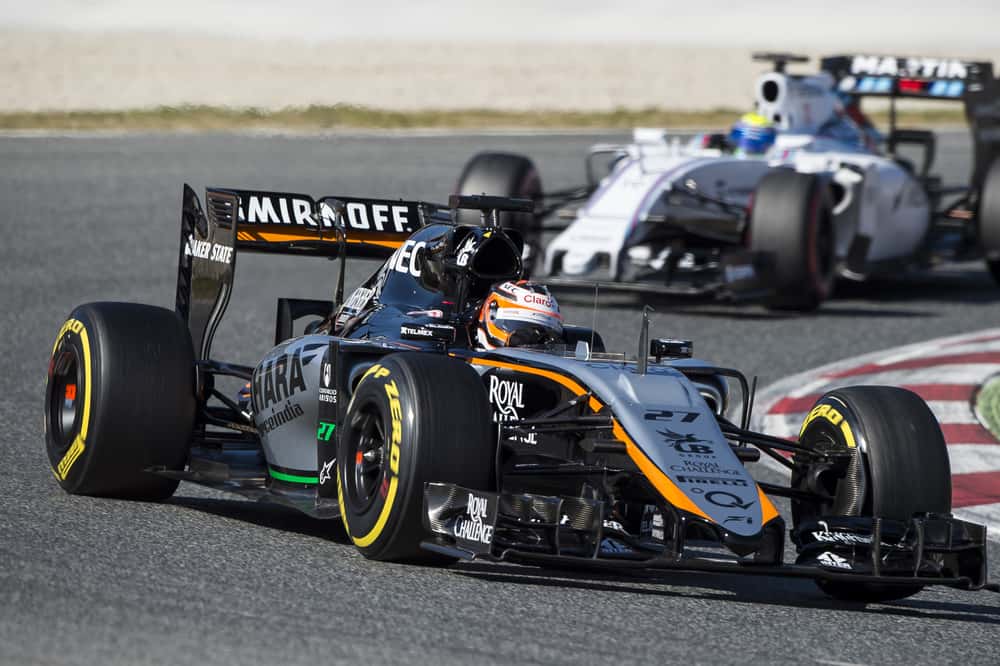
Conclusion
Formula 1 engines have come a long way since the earlier engines of the 1950s. They have gotten a lot more complicated and more energy and fuel-efficient than any of their early predecessors.
Lifespan and reliability have improved since earlier versions of the engines. It has also contributed to the sport of F1 becoming safer and less costly for teams to manage.
These engines are constantly evolving, and new engine regulations will be introduced from 2022 onwards. It is exciting to see how much more sophisticated engines will become, which will add more enjoyment and unpredictability to the sport.

